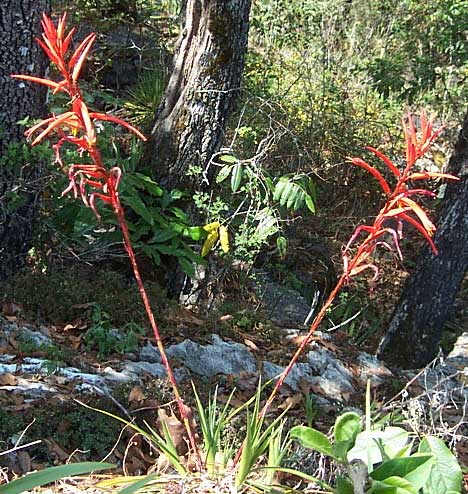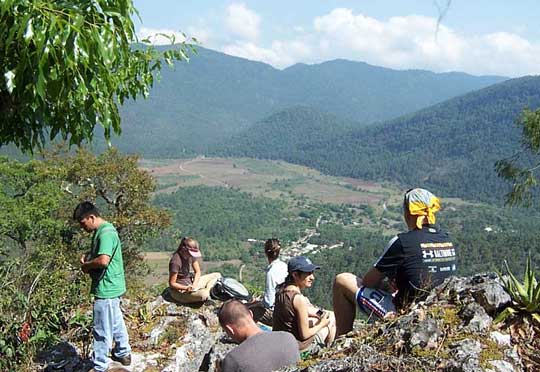Excerpts from Jim Conrad's
Naturalist Newsletter
from the April 28, 2007 Newsletter issued from Sierra Gorda Biosphere Reserve, QUERÉTARO, MÉXICO
PITCAIRNIA RINGENS

This Wednesday I joined up with a group of Peace Corps volunteers receiving their orientation to the Mexican experience by visiting various communities in the Reserve area. Soon the volunteers will be dispersed throughout the country for two years of many kinds of service.
On Thursday at San Juan de los Durán (elevation ~1400m or 4600ft, ~N21.47°, ~W99.17°), Don Tacho guided us up the very steep trail behind San Juan's eco-bungalows so we could enjoy the view across the valley. It was hard to keep from slipping on the trail not only because of its steepness but also because dry oak leaves created a very slippery surface.
However, the view from the top was worth the trouble. Below, you can see part of the group perched on the cliff-top's jagged limestone, with San Juan in the valley below, where with binoculars we could see a mule walking circles, pressing syrup from sugarcane stems:

In that picture, if you look in the lower, left corner, you barely can see a cluster of red flowers. That's the plant shown atop this page. It was a bromeliad. The vast majority of bromeliads live on trees as epiphytes, but this one was a ground-dweller. Pineapple plants also are ground-dwelling bromeliads. Our plant was clearly rooted among limestone rocks. Unlike most bromeliads, the bracts below each blossom in the inflorescence were small and inconspicuous.
Though I can't find illustrations to match this plant, my guess is that it's PITCAIRNIA RINGENS*, which has been identified in the area. The genus Pitcairnia is distinguished by most of its species growing in the ground or on cliffs and rock piles, and having brightly colored inflorescences and flower.
It was worth the leaf-slippery, arduous climb up the cliff just to see this amazing bromeliad at this most gorgeous stage of its life cycle!